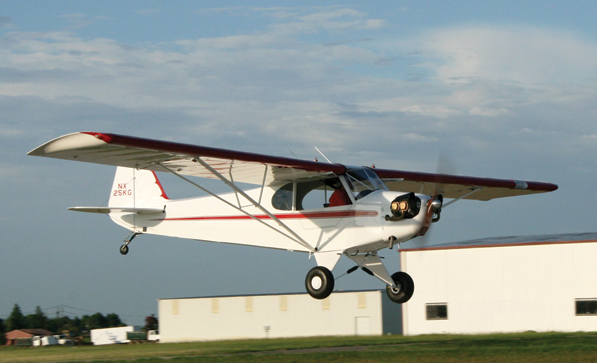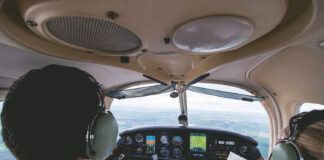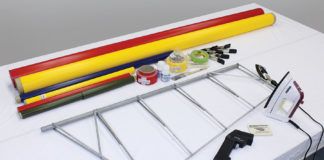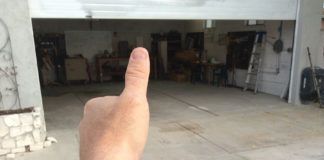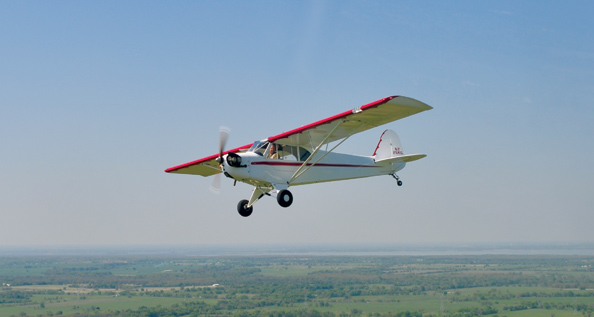
Tied down in the grass just south of EAA AirVenture’s brown arch and surrounded by lithe homebuilts and muscular aerobats wearing carnival colors, the gleaming white Cub seemed out of place. Cylinders poked out of its cowling like the noses of joyriding puppies, but the red leading edge scallops terminated in squared un-Cub-like wingtips. At the head of its simple double-edge fuselage stripe, white script proclaimed the airplane Scrappy. Its registration number, NX25KG, in 3-inch letters stacked on the rudder, said it was, indeed, a homebuilt. The Texas Sport logo embroidered on the front seat confirmed it.
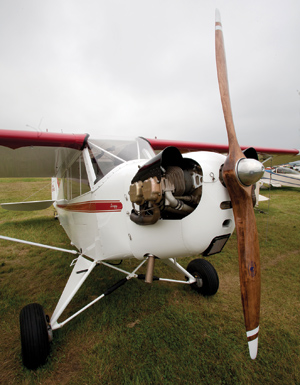
To maintain its cherry wood accents, Danny had Culver stain Scrappy’s wood prop in the same color.
Open clamshell doors framed the airplane’s owner, comfortably stretched out in a camp chair under the left wing. Permanently sun-browned, Kenneth Goggans invited me to sit and nodded at the empty chair whose white star and red, white and blue blocks located his accent in Texas. Sulphur Springs, to be exact. "I lived there all my life," Kenneth said, "except for a couple of years after high school, when I moved to New Mexico to work for the oil business."
Scrappy was a three-year project with Kenneth’s son Danny. "We barely got it finished and flew the 40-hour [test program] before we got up here," Kenneth said. This was his first time at AirVenture, and he said the air show was his favorite part. Technically, Scrappy is a Texas Sport kit, sold in Sulphur Springs by the American Legend Aircraft Company, but most of its pieces started life with other intentions. "The grandkids started calling it Scrappy," Kenneth added, "and it stuck."
Flipping through his thick, three-ring binder Kenneth pointed to and named many of his 11 grandkids and five great grandkids (with another on the way), which made the builder’s log a kind of family album. He shares Scrappy’s Kilo Golf initials with Danny’s wife, Kim, and three of their four children, Kris, Kyle, and Ken, the middle boy with whom he shares a name and a birthday. "We swap birthdays," Kenneth said, "and I have to ask him if he’s going to be 75 this year, and I’m going to be 28."
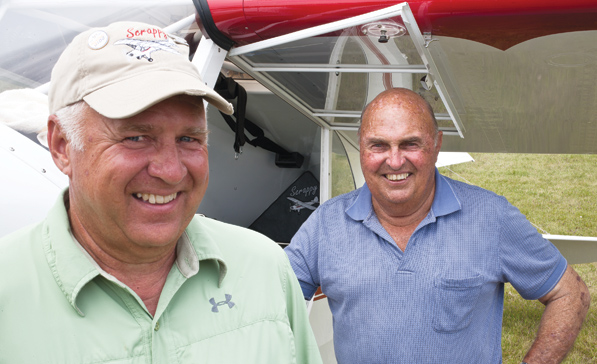
Danny Goggans, left, and his father, Kenneth Goggans.
Danny said that his daughter, Candace, claims a phonetic Kilo connection. An airline pilot (now on medical leave) and active flight instructor, Danny said he had reserved Delta Golf registrations for his airplanes about a month earlier. His Stearman and L-3 fly, but the J-3, Fly Baby, Jungmeister and Tailwind need some TLC before they once again aviate. Building Scrappy with his father-and flying it to Oshkosh-came first.
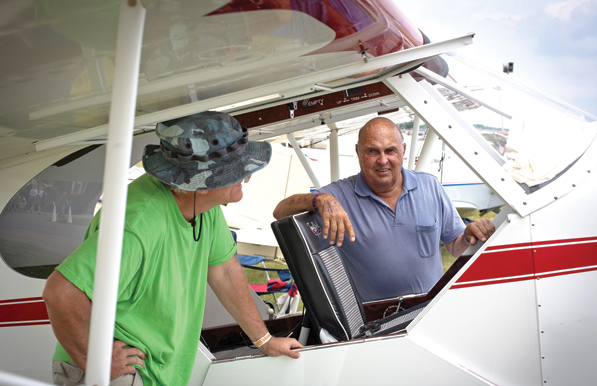
Kenneth talks about his airplane with an AirVenture visitor in 2010.
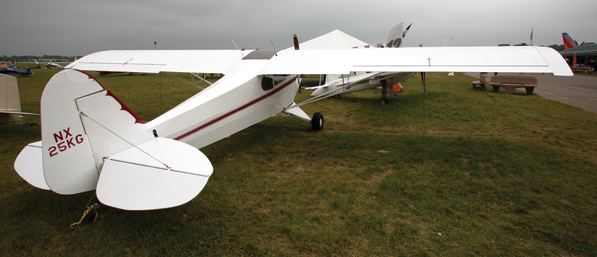
Buttoned up tight, the airplane waits out the Oshkosh weather.
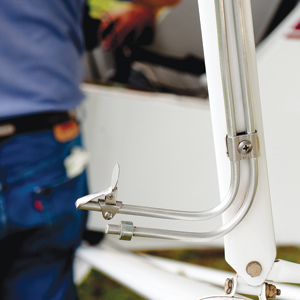
In keeping with its scrappy nature, the Texas Sport has an Aeronca pitot tube and static source.
Realizing a Dream
Danny is the oldest of three, said his father, followed by Lisa and Gary, and he’s the only pilot. "My wife, Sandra, don’t care doodley-squat about flying," Kenneth said, "but I’ve been interested in airplanes since I was big enough to see." Flying models scratched his aviation itch until the kids were grown and he had enough money to be able to afford getting his pilot license.
As he was with Scrappy, Danny was the catalyst that helped his dad realize that dream. Born in 1957 "with the aviation bug, Danny wanted to learn to fly when he was 15 or 16, and I wouldn’t let him," Kenneth said. "He needed to get old enough where he had more responsibility, and if he still wanted to do it, to go for it."
Also an avid modeler, Danny said, "I started flying right after I got married. My wife got mad at me, mom and dad got mad at me, my in-laws got mad at me." But it dawned on him that at 23, and as an owner of an International Harvester dealership that happened to be across the street from the airport, "I could go and do what I want."
Infused with a new pilot’s passion, which has clearly not waned, in 1983 Danny talked his dad into buying-and learning to fly-a 65-horsepower 7AC Champ. This was no small commitment. Having undergone bypass surgery at 47, Kenneth had to submit to an annual battery of tests for a special issuance medical. "I started flying as a Sport Pilot as soon as it passed," he said.
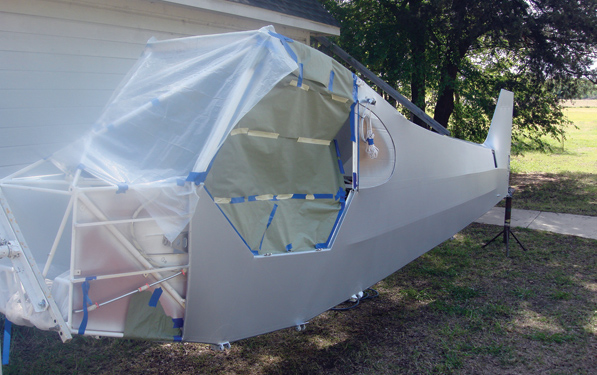
This is the final coat of silver before going to the first coat of color. The silver dried quickly and allowed the airplane to be painted outside. The surfaces were sanded between each coat to ensure a smooth finish.
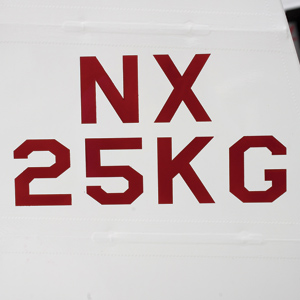
Kilo Golf stands for several members of the Goggans family, and the 25 represents the September birthday of Kenneth and his grandson Ken.
Let’s Make a Deal
After a career as an electrician, Kenneth retired from the Texas Utility Mining Company after he turned 58. Needing some money to pay off the house he’d built, he looked at his logbook, saw that he’d flown the Champ just six hours the previous year, and sold it. "They were selling good then," he said. "I gave $7800 for it and sold it for $14,800." During the decade it was his, the Champ needed nothing but oil changes and thorough annual inspections. "I’m one of those types that likes to know, just not think that it is OK," Kenneth said. "I know everything about that airplane, top to bottom. I know every screw, bolt, nut, cotter, key, washer and even the engine."
American Legend had Mattituck build four Experimental TMX O-200 engines for its prototype Light Sport Aircraft, the Legend Cub. Two were still in the crate, but Kenneth picked the engine that had powered the prototype through its test flights. If an engine is going to have problems, he said, it will be during the first 100 hours. Still, the engine had been sitting for a while, so he "took the jugs down, lapped the valves, and put in a new set of rings." He didn’t split the case because the camshaft was rust free. He built an oil-air separator with a spigot that drains a reservoir. "My Champ used to slobber out some terrible looking stuff," Kenneth said, "and I told Danny I didn’t really want to put it back in."
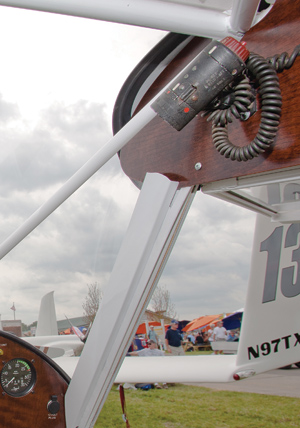
The Grimes panel light at the wingroot and the compass in the panel come from a Cessna 170 in which Danny made a memorable cross-country flight.
As American Legend’s test pilot, Danny was even more familiar with the engine. Longtime friends with the company’s founders, Danny traded his services for a Texas Sport kit, and Kenneth "bought" the engine by creating the patterns and crafting the interiors of the first 40 Legend Cubs. "It took me 30 hours to build a set of seats," he said, chuckling, "and I was supposed to be retired!"
Its prototype days over, the airplane became a trainer until a hard landing bent a tube between the upper and lower longerons above the right maingear mount. The stripped steel fuselage stood forgotten in the hangar’s shadows. When Kenneth was ready to collect the kit and start work, the busy company was a bit behind. Rather than wait, Danny said the bent tube would be an easy fix, so he would take the prototype fuselage. Company welders did the finish work when they added tabs and other fittings that brought the fuselage up to Texas Sport standards.
A similar deal was worked out for the wings, the only set built with square tips. "Basically, it’s a Dakota Cub wing," Danny said. "It’s got a 14-inch longer aileron on it, and I did the test flights." It never saw production because the return didn’t balance with the LSA certification investment.
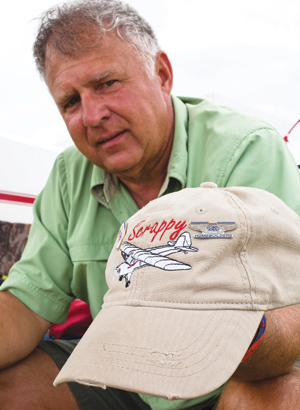
Danny shows off his custom cap.
Building at Home
Scrappy came together in Danny’s air-conditioned 18×30-foot shop. "He was still flying for the airlines when I was building on it, but he helped on it some," Kenneth said with a mischievous smile. "I didn’t make a job out of it. That’s why it took three years. I was doing this for fun, and that’s the way airplane building ought to be."
The two modified Scrappy to suit their needs. To counter the heavy stick forces of the bigger ailerons, they mounted them with ball-bearing rollers. Cessna-style fuel vents replaced the ram-air system to prevent total fuel loss should a cap come off, and they upped the stabilizer’s incidence, reaching for approach speed with full-up trim. "We didn’t get it," Danny said, "but it’s closer."
Like current production models, a stainless-steel rod connects the fore and aft throttles, replacing the cable that saps the back seat’s authority. Patting his belly, Danny said he shortened the rear stick, and installed a carb heat control. Scrappy wears nav, landing and taxi lights so that Danny can fly at night. There’s an electric attitude indicator in the panel because he’d been in several circumstances where things got a little hairy without one.
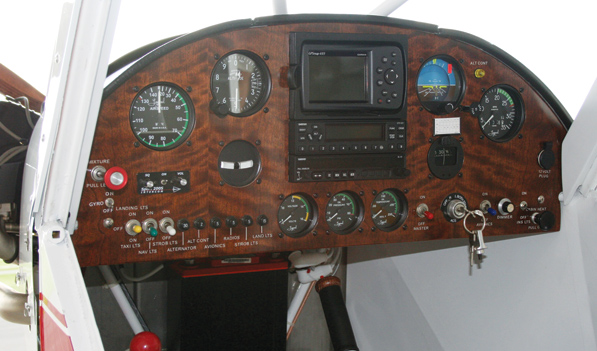
The panel contains a Garmin 495, Garmin 327 transponder, and Garmin SL40 com radio. The control stick has a cherry wood knob with push to talk button installed and hand-fitted leather wrap. The white paint brightens the cockpit with its dark cherry wood.
A Garmin stack dominates the panel. Bracketing the GTX 327 transponder, the AirGizmo mounted GPSMAP 495 feeds frequencies to the SL40 com and aural reports to the intercom. Switches march across the bottom of the panel in a logical flow, lights on the left and master, mags and avionics on the right. Danny is impressed with the Nulite Instrument Lighting System that illuminates the steam gauges, but the old black spotlight on the right wingroot is special. From a Cessna 170, that light and the compass in Scrappy’s panel got him safely home on a long night cross-country early in his flying career when his head was telling him he was going to Louisiana.
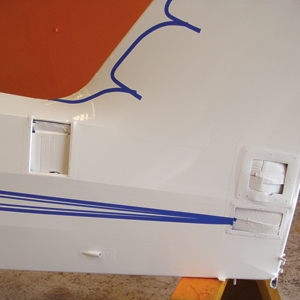
The airplane has received its last coat of white, and now the areas to receive pin stripes and scallops have been taped off.
A Group Project
Having every part of the family contribute to Scrappy was one of Danny’s goals. Going for a classic Cub look, and with a passion for dark cherry wood, Danny turned to his wife, daughter and daughters-in-law, all interior decorators. "With so much wood inside, the girls told us it was gonna be dark," so the airplane was painted white, inside and out. Carrying the theme forward, Scrappy would soon wear a Culver Prop stained dark cherry. Danny’s Uncle Jim was making cherry stick grips, but he succumbed to a heart attack before finishing the set. Kenneth has kept the grips in memory of Jim.
Picky about matching colors, Danny said his dad couldn’t find vinyl that matched the airplane’s red trim, so he went with black vinyl and houndstooth fabric. The black vinyl panel aft of the baggage compartment not only displays Scrappy’s embroidered image and name, it hides a boo-boo with the paint, a run. Also located out of sight were baggage compartment pockets for a fuel tester, quart of oil, and Kenneth’s logbook.
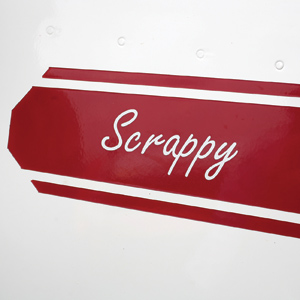
Scrappy’s name is reversed out of its trim stripes.
One run should be forgiven anyone who paints an airplane outside, under an oak tree. That’s where Kenneth shot Stits on Ceconite. He rarely had to bend, stretch or stoop, he said, because he hung the target of his sprayer from the bucket of Danny’s tractor. American Legend lent the two its paint booth one weekend for Scrappy’s Ranthane finish coats, and its scales for the final weigh-in-936 pounds empty.
Danny made the first flight on July 5, 2010. After he gave his father, in a friend’s taildragger, the 3 hours of training the insurance company wanted, they started the 40-hour test program, often flying three times a day, even when the temperature topped the century mark. Danny took several days off to tow his camper to Wisconsin, leaving his truck in Madison and flying home. Eighteen days later, father and son fired up Scrappy at 0820 for their Oshkosh adventure.
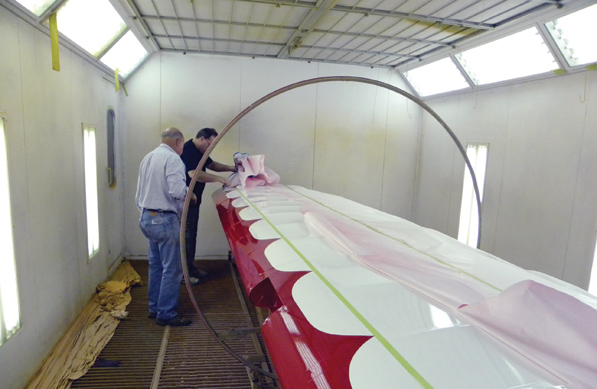
Kenneth Goggans and painter Ron Lusher carefully unmask the red scallops in the paint booth. After years of labor there is much anticipation to see the final look of the wings.
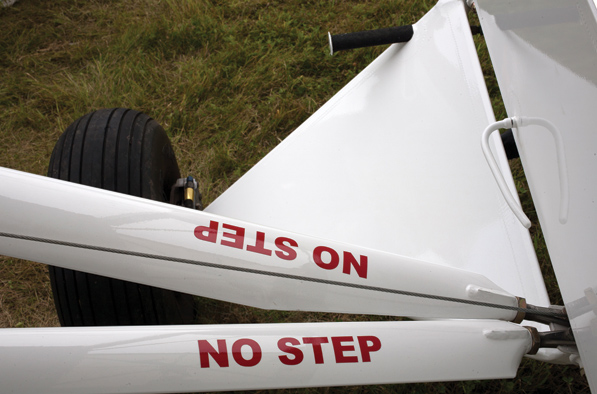
From either side, the point is clear.
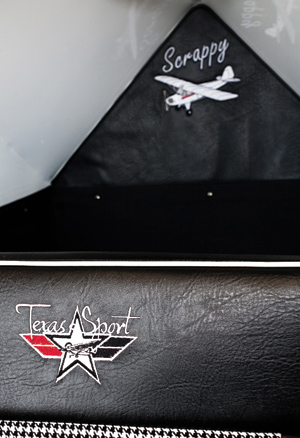
Embroidery on Kenneth’s custom seats gives the airplane’s make and model, and in the baggage compartment, its moniker.
Sitting up front, Dad did most of the flying. "It was a nice trip," Kenneth said, but on the heels of all the test flying, he was ready to quit when they reached Madison at 2030. In deference to his dad’s Sport Pilot privileges and the approaching darkness, Danny flew the last leg to the capitol’s towered-controlled airport. The rest of the flight, Danny was on his cell, checking the weather. They drove back to Madison Saturday morning for Danny’s flight into Wittman Regional Airport.
Clan Goggans would be joining its patriarch under Scrappy’s wings on Friday at AirVenture, flying up in the Citation operated by the oil company Danny’s son Ken started. "This is a once in a lifetime trip for us," Kenneth said, and building Scrappy united four generations. Owning a score of airplanes over that past three decades, for unapologetically sentimental reasons, Danny said there were two he’d never sell. The first was the Stearman, because he taught his son Ken and Uncle Jim’s son Brandon (who went on to fly F-18s and then for the airlines) to fly in it. The second is Scrappy.
In the three-ring binder is a photo of a youngster leaning over a wing with Goggans, happily wielding an iron. "That’s my grandson, Colin," Danny said. In addition to the picture of him working on the airplane with his great grandfather, Colin will one day have the plane, Danny said. "That’s pretty special."
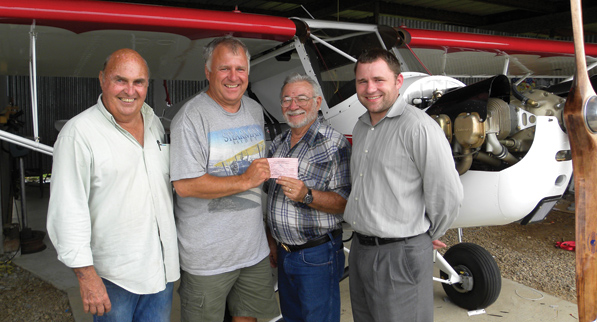
The joy of receiving the airworthiness certificate. Pictured from left to right are: Kenneth Goggans, Danny Goggans, DAR Mel Asberry and Ken Goggans, Danny’s son and future owner of the airplane. Three generations of pilots currently fly Scrappy.
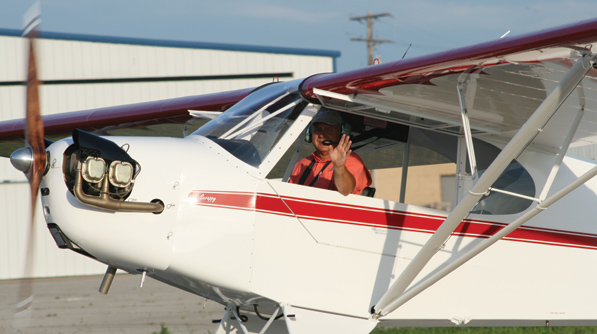
Danny Goggans taxis out for Scrappy’s first flight.
